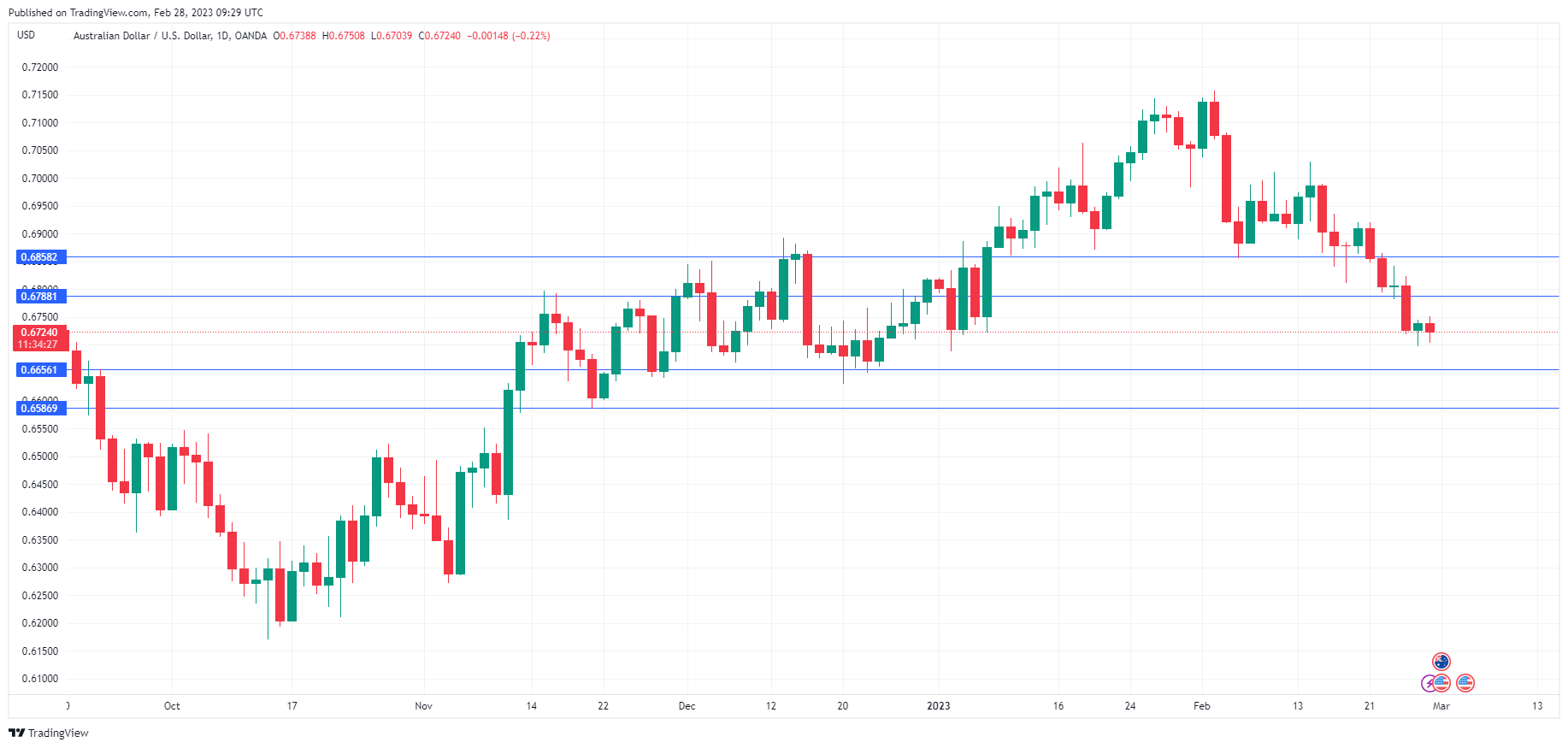
- All Instrument Types
- Indices
- Equities
- ETFs
- Funds
- Commodities
- Currencies
- Crypto
- Bonds
- Certificates
Please try another search

AUD/USD Eyes CPI, GDP

The Australian dollar remained under pressure and edged lower on Tuesday. AUD/USD dropped below the 0.67 line on Monday for the first time since Jan. 3.
Australian retail sales bounce back.
Australian retail sales jumped 1.9% m/m in January, following an upwardly revised 4% decline in December and beating the consensus of 1.5%. The data indicates that consumer demand remains resilient despite rising interest rates and higher inflation.
For the RBA, the upswing in consumer spending indicates that the economy can continue to bear higher rates. The central bank has hiked 325 basis points since May 2022 to curb inflation. The cash rate is currently at 3.35%, and the markets have priced in a peak rate of 4.3%, with four rate hikes expected before the end of the year – one more than what is expected for the Fed. The RBA meets on Mar. 7 and is widely expected to raise rates by 25 basis points.
Wednesday could be a busy day for the Australian dollar as Australia releases inflation and GDP reports. Inflation for January is expected to ease to 7.9% y/y, following an 8.4% gain in December. GDP for the fourth quarter is projected to slow to 2.7% y/y after a robust gain of 5.9% in Q3. A decline in inflation and GDP would indicate that high-interest rates are having their intended effect and slowing economic activity. The question is whether the RBA can guide the slowing economy to a soft landing and avoid a recession.
In the US, a recent string of solid numbers has raised speculation that the Fed could raise interest rates as high as 6%. The unseasonably warm weather in January may have played a part in the better-than-expected numbers, and we’ll have to see if the positive data repeats itself in February.
The markets have shifted their stance from a final rate hike in March with rate cuts late in the year to pricing in three more rate hikes in 2023. If upcoming inflation, employment, and consumer spending reports point to a weaker economy, we can expect the markets to revert to pricing in a dovish pivot by the Federal Reserve.
AUD/USD Technical
- AUD/USD has support at 0.6656 and 0.6586
- There is resistance at 0.6788 and 0.6858
Related Articles

The BOJ’s policy shift continues to strengthen the yen, keeping USD/JPY under pressure. Rising Japanese bond yields signal further tightening ahead, reinforcing the bearish...

U.S. economic growth fears mount as data disappoints, weighing on USD European data surprises fuel optimism, boosting EUR/USD Bond markets signal diverging growth outlooks for...

CHF/JPY Forex Strategy is Bearish: We are currently @ 166.78 in a range. If we can break slope support, we are looking for a continuation to the ATR target @ 165.97 area, with a...
Are you sure you want to block %USER_NAME%?
By doing so, you and %USER_NAME% will not be able to see any of each other's Investing.com's posts.
%USER_NAME% was successfully added to your Block List
Since you’ve just unblocked this person, you must wait 48 hours before renewing the block.
I feel that this comment is:
Thank You!
Your report has been sent to our moderators for review






Add a Comment
We encourage you to use comments to engage with other users, share your perspective and ask questions of authors and each other. However, in order to maintain the high level of discourse we’ve all come to value and expect, please keep the following criteria in mind:
Enrich the conversation, don’t trash it.
Stay focused and on track. Only post material that’s relevant to the topic being discussed.
Be respectful. Even negative opinions can be framed positively and diplomatically. Avoid profanity, slander or personal attacks directed at an author or another user. Racism, sexism and other forms of discrimination will not be tolerated.
Perpetrators of spam or abuse will be deleted from the site and prohibited from future registration at Investing.com’s discretion.